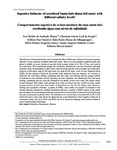Please use this identifier to cite or link to this item:
http://www.alice.cnptia.embrapa.br/alice/handle/doc/1064874| Title: | Ingestive behavior of crossbred Santa Inês sheep fed water with different salinity levels. |
| Authors: | MOURA, J. H. A. de  ARAUJO, G. G. L. de   SARAIVA, E. P.   ALBUQUERQUE, I. R. R. de   TURCO, S. H. N.   COSTA, S. A. P.   SANTOS, N. M.   |
| Affiliation: | JOSÉ HELDER ANDRADE DE MOURA, UFPB; GHERMAN GARCIA LEAL DE ARAUJO, CPATSA; EDILSON PAES SARAIVA, Professor da UFPB; ÍTALO RENEU ROSAS DE ALBUQUERQUE, UFBA; SÍLVIA HELENA NOGUEIRA TURCO, Professora da UNIVASF; SAMIR AUGUSTO PINHEIRO COSTA, UNIVASF; NILMARA MERCIA SANTOS, UNIVASF. |
| Date Issued: | 2016 |
| Citation: | Semina: Ciências Agrárias, Londrina, v. 37, n. 2, p. 1057-1068, mar./abr. 2016. |
| Description: | The objective of the present study was to evaluate the effect of four water salinity levels on the ingestive behavior of non-castrated crossbred Santa Inês sheep. Thirty-two non-castrated crossbred Santa Inês sheep in feedlot, at seven months of age and initial average weight of 21.76±1.25 kg, were used in the experiment. The experimental design was completely randomized, with four treatments and eight replicates. Four concentrations of salts in the water fed to the animals were evaluated: low (640 mg/l); medium (3,188 mg/l); high (5,740 mg/l) and very high (8,326 mg/l) levels of total dissolved solids (TDS). For the ingestive behaviors, the animals were observed every ten minutes, for 24 hours, to determine the time spent feeding, ruminating and idle. Also, cud chewing and the average number of defecations and urinations and the frequency of water ingestion were determined. The time spent feeding, ruminating and idle were not changed by the salinity levels in the water. Dry matter intake, neutral detergent fiber intake, total chewing time, total cud chews per day, number of daily meals, average duration of each meal and number of defecations per day did not change either. However, feeding and rumination efficiency in grams of DM/h, water intake and number of urinations were linearly affected, whereas the variables rumination efficiency in grams of NDF/h, grams of dry matter per cud, grams of neutral detergent fiber per cud, number of cuds, number of chews per cud and chewing time per cud presented quadratic effect. The different levels of total dissolved solids (640; 3,188; 5,740; and 8.326 mg/l) in the water fed to the sheep did not cause alterations in their ingestive behavior. In conclusion, water with up to 8,326 mg TDS/l can be an alternative strategic and seasonal method to water crossbred Santa Ines sheep. |
| Thesagro: | Produção animal Ovino Água Salina Consumo Defecação Ruminação |
| NAL Thesaurus: | Animal production |
| Keywords: | Raça Santa Inês Ócio |
| DOI: | 10.5433/1679-0359.2016v37n2p1057 |
| Type of Material: | Artigo de periódico |
| Access: | openAccess |
| Appears in Collections: | Artigo em periódico indexado (CPATSA)  |
Files in This Item:
| File | Description | Size | Format | |
|---|---|---|---|---|
| Gherman1.pdf | 407,77 kB | Adobe PDF |  View/Open |









